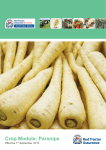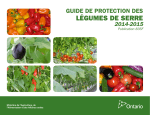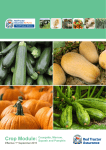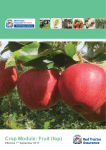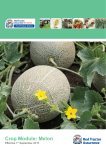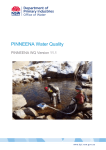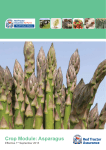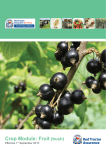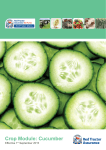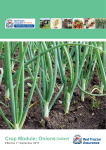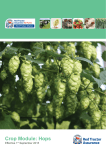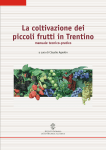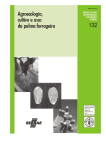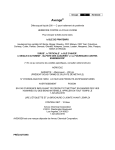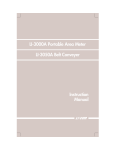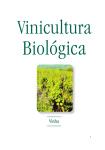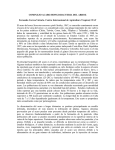Download Crop Module: Strawberries
Transcript
Crop Module: Strawberries Effective 1st September 2015 Welcome T his crop specific module for strawberries has been written to complement and avoid duplicating the generic principles of the Red Tractor Farm Assurance Fresh Produce Scheme standards. It is advisable to read the Red Tractor Farm Assurance Fresh Produce standards before reading this crop specific module. This module is designed to stimulate thought in the mind of the reader. It contains crop specific guidance and standards, where applicable, in addition to the requirements stated in the generic Fresh Produce standards. Within this module the important requirements outlined in the crop specific standards section will be verified during the Red Tractor Farm Assurance assessment and compliance will form a part of the certification/approval decision. Disclaimer and trade mark acknowledgement Although every effort has been made to ensure accuracy, Assured Food Standards does not accept any responsibility for errors and omissions. Trade names are only used in this module where use of that specific product is essential. All such products are annotated® and all trademark rights are hereby acknowledged. General Introduction Following a systematic approach will help growers identify and manage the risks involved in crop production. This module is based on a typical crop production process and food safety, health & safety, environmental and quality hazards are identified. Appropriate controls may then be established to minimise risk. Food safety and health & safety issues always take precedent over quality and environmental controls. The layout of this module follows the same structure as that used in the Red Tractor Farm Assurance Fresh Produce Standards. The content of the module is reviewed prior to the issue of updated editions. The review process considers both new developments and all relevant technology which has emerged since the last review was completed and which have been found to be both workable by the grower and beneficial to the environment. The aim is to transfer such information and technologies to growers. Acknowledgements Red Tractor Farm Assurance Fresh Produce gratefully acknowledges the contribution of all consultees in the preparation of this protocol, particularly members of National Summer Fruits and Janet Allen of ADAS UK Ltd. Notes: Pesticide Information The Red Tractor Fresh Produce team has been working with Fera to provide tailored access to the LIAISON database for all Red Tractor Fresh Produce members. This system allows individual growers access to all information for plant protection products approved for use under the Red Tractor Fresh Produce Scheme. LIAISON can be accessed under the Produce tab via the “Checkers and Services” page where you will also find a user manual. Searches will be filtered specifically for the crops for which you are registered. Once you have logged onto the site and clicked on the LIAISON hyperlink you will be directed to the LIAISON home screen. You will need a username and password and these will be sent once you have registered: http://assurance.redtractor.org.uk/rtassurance/ services/Registration/members.eb . Front cover image credit: British Growers Association Ltd. 1 Red Tractor Assurance for Farms – Crop-specific Module: Strawberries © Assured Food Standards 2015 Content Contents ADDITIONAL REQUIREMENTS AGAINST CURRENT STANDARDS 02 CROP SPECIFIC STANDARDS02 CHOICE OF VARIETY OR ROOTSTOCK AND PLANT HEALTH CERTIFICATION 03 SITE AND SOIL MANAGEMENT 03 ENVIRONMENTAL PROTECTION AND CONTAMINATION CONTROL05 NUTRITION 11 IRRIGATION12 HARVEST AND STORAGE 12 RESIDUES AND CONTAMINANTS 12 APPENDIX 1: SOIL STERILANTS13 APPENDIX 2: TYPICAL FERTILISER REQUIREMENTS FOR STRAWBERRIES14 APPENDIX 3: G UIDELINES FOR MINIMISING PESTICIDE RESIDUES 18 APPENDIX 4: ACTIVE INGREDIENTS FOUND IN UK STRAWBERRIES19 ADDITIONAL REQUIREMENTS AGAINST CURRENT STANDARDS STANDARDS HOW YOU WILL BE MEASURED RECORDS (to be kept for 2 years) n Crop inspection records/ IM.b diary notes and subsequent recommendations Regular crop inspections must be undertaken and recorded CROP SPECIFIC STANDARDS STANDARDS HOW YOU WILL BE MEASURED RECORDS (to be kept for 2 years) n Soil analysis records CQ.31.a Prior to planting, a soil analysis must be carried out to ascertain existing soil levels of the macronutrients P, K, Mg and pH levels n Existing soil nutrient CQ.31.b The composition of composted green waste, organic manures or composts applied to the soil pre-planting, particularly pH and nutrient status, must be determined before use levels are taken into consideration before use n Composted green waste/organic manures/compost analysis records n Irrigation water analysis CQ.31.c In order to design a suitable fertigation programme to use for in-substrate grown crops, the water used for irrigation must be analysed records n Irrigation records CQ.31.d Irrigation requirements must be planned using soil moisture monitoring devices such as a neutron probe or tensiometer or a scheduling system n Field to pack house or CQ.31.e To avoid fruit contamination during transit from the field to the pack house or cold store, it must be transported within an enclosed vehicle or trailer Red Tractor Assurance for Farms – Crop-specific Module: Strawberries cold store transport and handling protocol © Assured Food Standards 2015 2 GUIDANCE CHOICE OF VARIETY OR ROOTSTOCK AND PLANT HEALTH CERTIFICATION When purchasing strawberry plants, growers should ensure that they are of the highest possible health status, preferably certified material and their quality meets the specifications for which they are intended. Similarly plants being raised by growers for their own use should be of the highest health status and preferably certified. Where growers require assurances from propagators that plants have been raised within the auspices of the Red Tractor Farm Assurance Fresh Produce Scheme, they should request a verification number from their propagator. SITE AND SOIL MANAGEMENT SITE HISTORY Sites, which are not prone to frost, and which have good shelter from wind are preferred for strawberry production. Both wind and frost damage in the spring can lead to increased fungal disease risk especially botrytis to flowers and fruit, which may necessitate increased fungicide applications. Where it is planned to cover a strawberry crop with temporary structures e.g. Spanish or French tunnels, a site should be chosen with good wind protection to prevent removal of polythene by gale force winds. A wide range of soils are suitable for strawberry growing including loamy sand, sandy loam, loam, silty loam, sandy silty loam, silt, clay loam and silty clay loam. However, very heavy clay soils are generally unsuitable due to poor aeration and drainage problems. In all cases avoid soils which are poorly drained or with a high water table. Waterlogging in winter increases the spread of soil borne diseases particularly red core (Phytophthora fragariae var fragariae). Waterlogging in itself can cause anaerobic conditions unsuitable for strawberry roots and is likely to cause significant root death. This problem can be overcome on many sites with adequate field drainage and the use of raised beds. Some sandy soils are prone to slumping and compaction after wet weather. A high standard of soil cultivation and management is required to alleviate this problem. The use of polythene mulch virtually eliminates the aforementioned risk. 3 The window for the cultivation of the soil can be very narrow on heavier soils. Care should be taken to make optimum use of the window, i.e. when soil moisture conditions are ideal to raise a good tilth without compaction, smearing or producing clods of soil. Avoid the use of soils that have grown linseed, flax, hops, peas, runner beans, potatoes or other crops which are likely to introduce or enhance the levels of inoculum of Verticillium dahliae unless a soil test reveals the level of verticillium wilt to be acceptably low. When selecting fields for strawberry production, consideration should be given to soil structure, drainage, texture, pH, soil depth, exposure of the site to prevailing winds, susceptibility to spring frosts and endemic soil borne pests and diseases Where crops are protected by Spanish or other polythene clad structures care should be taken to ensure that suitable & adequate provision is made for the drainage of water from the roofs of these structures on and away from the field where this crop is being grown. This is necessary so as not to cause soil erosion flooding or diffuse pollution of nutrients or pesticides into adjacent or other water courses or catchment areas. ROTATIONS Continuous cropping of strawberries on the same land can lead to a build-up of verticillium wilt, crown rot and red core as well as many non-specific disease organisms such as pythium and rhizoctonia. Migratory nematodes, which cause direct feeding, damage, to the roots of strawberry plants e.g. Pratylenchus penetrans, or may cause damage and act as virus vectors i.e. Xiphinema diversicaudatum and Longidorus spps, may also increase to unacceptable numbers where strawberries are grown repeatedly. Rotating with arable crops including cereals, oil seed rape, grass leys, maize and vegetables can reduce this risk. However, care should be taken to avoid the planting of crops in the year immediately prior to strawberries, e.g. maize or sweet corn or any other crops, where residual herbicide usage is likely to incur the risk of soil residues, potentially very damaging to the following crop. Where adequate land is available to permit the planting of strawberries in rotation with other arable crops, these should not include linseed, lucerne, flax, hops, peas, runner beans or potatoes as these are likely to enhance verticillium levels in the soil. Red Tractor Assurance for Farms – Crop-specific Module: Strawberries © Assured Food Standards 2015 The minimum rotational break should be 3 years following a 3 year crop of strawberries, or 2 years following a 2 year crop of strawberries. For annual cropping 3 successive crops can be taken before the planting of a break crop or crops, assuming no disease problems are encountered in the first 2 years. Long rotational breaks of 5 years or more usually provide additional yield benefits and should be considered where it is practical to do so (see Environmental Protection Section) FIELD SITING ‘Everbearer’ strawberry varieties tend to be more susceptible to fruit infection by powdery mildew. Although Everest, Evie 2, Finesse are classed as moderately resistant to mildew other cultivars are highly susceptible to this disease. It is important therefore, to protect ‘Everbearers’ from this disease to apply a suitable fungicide programme prefruiting. The problem can be exacerbated if everbearers are grown next to ‘June bearer’ varieties of strawberry, especially those i.e. Elsanta, Elegance which are very susceptible to mildew. Therefore plant ‘Everbearer’ varieties at least 150 metres away from the nearest plantation of ‘June bearers’. tray or misted tip plants used. A succession of batches, of plants of a single e.g. Elsanta, Sonata or several June bearing cultivars being planted, in the late winter, spring or autumn and plants of Everbearer varieties planted in the autumn or more usually the early spring can be used to provide as long as possible a harvest period. Where the strawberry crop is grown under glasshouse, fixed or temporary polythene clad tunnels it is important that all additional operator and crop safety requirements are observed when applying agrochemicals under these structures especially with regards to temperature. It is inadvisable to allow the temperature to rise above 28°C even for short periods. The preferred maximum temperature is 25°C. Venting or the uncovering of crops should be carried out before this temperature is reached. If using floating film under polythene tunnels or double layers of floating film outside, a temperature controlled warning device should be used such as a siren or alarm bell. Additionally if two layers of floating film are used the top layer should be removed during the day once flowers are open. In all cases uncovering or venting is advised to improve pollination when outside temperature is 15°C or above. SOIL FUMIGATION Avoid planting new strawberries of any variety next to an old plantation of strawberries; especially if high levels of two-spotted spider or tarsonemid mite, vine weevil or powdery mildew are present in the existing plantation (see Environmental Protection Section) Soil sterilisation should be avoided where the possibility of rotating the cropping exists. It is however accepted that this is not always possible and soil sterilisation may be required. Soil sterilisation must only be undertaken where necessary. EXTENDED SEASON PRODUCTION Only sterilise the soil when there is a known disease risk present. Do not sterilise solely for purposes of weed seed elimination. The following sterilants are currently approved for use prior to planting strawberries: Under in UK climatic conditions most ‘June bearer’ strawberry varieties will crop naturally over a period of 3 to 4 weeks and everbearers for 10 to 12 weeks. It is, therefore, necessary to grow a range of varieties and to use a range of production techniques and planting dates to achieve continuous cropping over an extended period. Without providing the crop with heating it is possible to harvest from mid-May to late October-early November. With heat it is possible to extend the season still further from early April to late December. To enable the harvest period to be extended growers provide crops with protection by planting under glass, glasshouses or fixed polythene clad tunnels, or by covering open field grown crops with temporary structures e.g. Spanish or French tunnels. Open field grown crops may be covered with floating crop covers to advance or covered whilst they are still dormant in late winter with straw to delay harvest. Planting may be into the soil or into soil-less media, usually comprising of peat or coir, or a hydroponics system of production used. A range of planting material e.g. fresh dug bare root, or cold stored runners, cold stored waiting bed, or nchloropicrin n metam dazomet sodium n steam Further details are given in the Appendix. Growers should assess the need for using any soil sterilant (see Appendix), assuming the responsibility of keeping in touch with new developments as regards the treatment of soil, pre-planting, for pest, disease and weed control through conferences, workshops and regular contact with advisors. Before using a soil sterilants growers should carry out a COSHH assessment, as required by law. Consider the risk to the environment, the operator and the subsequent crop. Carry out a cress germination test if required prior to planting (see Appendix). Red Tractor Assurance for Farms – Crop-specific Module: Strawberries © Assured Food Standards 2015 4 SUBSTRATES Crops in soil-less media a. Good crop and field hygiene. An increasing number of growers grow strawberries in substrate, using bags or troughs filled with peat or coir based compost. These bags or troughs are either laid or stood down on the ground or on a variety of different support systems. In many cases, such crops are covered with Spanish or French tunnels. b. Promoting crop health by maximising nutrient availability through soil analysis and accurate application to avoid excess. When setting up such a plantation, care should be taken to lay out the bags or containers in such a way so as to ensure optimum use of agrochemicals with minimal wastage. Where appropriate, steps should be taken to make the necessary adjustments to spray applicators or to use applicators designated for this crop use alone. Crops grown on support systems e.g. table-tops can be more prone to powdery mildew infection. So where this system of production is being used and market requirements permit, tolerant or resistant varieties should be grown to prevent over reliance upon fungicides. Before committing to in substrate production an appraisal should be made of the quality and the amount of water that is available to support this method of production. In addition the management i.e. removal and or treatment of drainage water produced from the bags or troughs and the leached nutrients it contains should be considered, so as to avoid the diffuse pollution of water. ENVIRONMENTAL PROTECTION & CONTAMINATION CONTROL PEST, DISEASE AND WEED CONTROL Pest control Introduction The guiding principle is that pesticide inputs should be minimised through prevention rather than cure. An integrated approach should be adopted to achieve this involving the following management steps. Good management and planning a. Careful site selection to avoid potential or previous pest problems thereby enhancing plant health. b. Sensible crop rotations to avoid build-up of problems. c. Inclusion of resistant varieties in cropping programmes whilst respecting the need to meet the required quality parameters and eating requirements. 5 Cultural preventative techniques c. Utilising irrigation as a control measure wherever appropriate and feasible. Corrective action If the above should fail to prevent or control the pests, the following approach should be adopted: a. Establish the need to take corrective action by regular monitoring and referring to thresholds (where established). The effect of the prevailing weather conditions should also be considered. b. Where corrective action is required, biological and natural methods of pest and disease control, if available, must be considered first. c. If chemical control is needed, the following points should be considered, whilst ensuring effective control is achieved: n Use the least toxic and persistent product with due respect to its eco-toxicity. n Use the product most selective to biological control agents and naturally occurring beneficial organisms. n Use the minimum effective dose rate. n Use appropriate application methods with effectively maintained equipment, and spot treating wherever possible. APPROVED USES NOT INCLUDED ON THE PRODUCT LABEL In many circumstances, particularly for minor crops, product labels do not include all of the approved uses and growers wishing to check the approval notice of a particular product should note that this information is available using the LIAISON® search accessible via their RED TRACTOR Farm Assurance home page after logging in. A search on the ‘Extensions of Authorisation for Minor Use’ page of LIAISON® by crop or product name should yield a results page. A click on the product name should link to a summary of the approval information. Near the bottom of the summary is the specific off-label number (e.g. 0246/09) and this link will open up a pdf of the original EAMU document giving details of the extension of use. Red Tractor Assurance for Farms – Crop-specific Module: Strawberries © Assured Food Standards 2015 CULTURAL CONTROL Integrated control Site selection Integrated control of pests on strawberries includes cultural, biological and chemical control however; its most important feature is regular crop monitoring. This should be carried out either by trained farm staff or a qualified advisor at least fortnightly during the growing season for aphids, two-spotted spider mites, caterpillars especially tortrix, seed beetles, tarsonemid mite, slugs, vine weevil, blossom weevil, capsids and other minor pests. ‘Ever bearer’ strawberry varieties should be monitored more frequently during their flowering period i.e. at least weekly and preferably twice per week for thrips, tarnished plant bug and other flower pests. Avoid planting in soils known to be infested with vine weevil or adjacent to crops such as blackcurrants, raspberries, blackberries or other strawberry crops, where the presence of this pest has been confirmed. If possible avoid sites adjacent to large areas of wasteland or set-aside land where thrips, blossom weevils and tarnished plant bugs are likely to be a problem. If possible avoid planting strawberries, into land which has been used long term for permanent pasture. Where as a result there is a high risk of the presence of soil borne insect pests i.e. the larvae of wireworm, leatherjackets and cockchafer. If planting of such sites cannot be avoided then soil samples should be taken, pre the destruction of the grass sward, to determine the level of infestation by wireworm larvae and hence the risk of damage to the strawberry crop. Where high levels of this pest are found the use of a break crop or crops, prior to planting the strawberries may be considered or partial soil sterilisation may need to be used to render the site suitable for this soft fruit crop. Avoid soils with high populations of nematodes especially virus vectors Xiphinema and Longidorus. Economic thresholds should be observed where applicable. The following tentative thresholds should be used only as a guide: e.g. onion or rose thrips Three per flower Western flower thrip thris One per flower Tarnish plant bugs One per ten plants Two spotted spider mite 3 per leaflet or 9 per trifoliate leaf of ex-diapausal adults in March, or actively feeding adults, juveniles or eggs during crops growing season Strawberry aphid 1 aphid per mature leaf or one per three young leaves. Nil tolerance if virus is likely to be present on the field or in adjacent fields Strawberry blossom weevil When notches observed in petals of open flowers or as soon as first flower buds with partially or severed stalks found. Pheromone traps can also be used for detecting and monitoring this pest in strawberry crops Shallot aphid Nil tolerance Tarsonemid mite Nil tolerance Vine weevil Nil tolerance Spotted winged drosophila Install traps in plantations & on adjacent wooded land to detect for and monitor adult pest , also carry out routine checking of waste fruit for presence of larvae (see AHDC web site for details of monitoring methods for this pest) Rotations Soil borne pests such as vine weevil and nematodes are less likely to become a problem with good use of crop rotation (see previous comments on rotations, in Site and Soil management). If you are not sure of the nematode status of your soil a test should be carried out. Irrigation Plants that are under stress from lack of water are more susceptible to certain pests such as two-spotted spider mite and tarsonemid mite. Avoid the plants coming under water stress. Trash and runner removal Removing trash and unwanted runners is in the main practised to aid the control of fungal diseases. However the levels of two-spotted spider mite may also be reduced if trash e.g. dead foliage, straw, etc. is removed from the field during the dormant period. Overwintering sites for slugs and tarnished plant bugs will also be reduced. Red Tractor Assurance for Farms – Crop-specific Module: Strawberries © Assured Food Standards 2015 6 Biological control Predatory and parasitic organisms are available to control a wide range of pest problems on horticultural crops. In many cases they are the most effective and most economic choice. With strawberry culture at the present time there are several commercially proven biological control organisms available. Phytoseiulus persimilis controls two-spotted spider mite, Amblyseius cucumeris tarsonemid and Bacillus thuringiensis controls the caterpillars of tortrix moths, (see Appendix). These should be used as the first choice for both outdoor and protected cropping. Capsids Lambada-cyhalothrin outdoor & protected crop (EAMU), Thiacloprid (EAMU) outdoor & protected crop, dodecylphenol ethoxylate when applied for two spotted spider mite control outdoor & protected crop Caterpillars including tortrix Chlorpyrifos outdoor & protected crop, Bacillus thuringiensis, indoxacarb EAMUs for outdoor crop, pyrethrins outdoor & protected crop, spinosad protected crop when used for control of thrips Spider mites abamectin (EAMU) for use on outdoor propagation and protected fruiting crops, clofentezine (EAMUs) outdoor & protected crop , dodecylphenol ethoxylate, chlorpyrifos outdoor & protected crop, maltodextrin, tebufenpyrad outdoor & protected crop, spiromesifen (EAMU) protected crop, bifenazate protected crop, fenpyroximate (EAMU) outdoor & protected crop, etoxazole (EAMU) protected crop, spirodiclofen (EAMU) outdoor & protected crop, Verticillium lecanii (EAMU) protected crop Slugs and snails ferric phosphate outdoor & protected crop, metaldehyde outdoor & protected crop Seed beetle No pesticides for control Tarsonemid mite abamectin (EAMU) for use on outdoor propagation and protected fruiting crops, fenpyroximate (EAMUs) outdoor & protected crop Vine weevil Chlorpyrifos outdoor & protected crop Chafer grubs, wireworms, leatherjackets none recommended Whitefly dodecyl phenol ethoxylate, maltodextrin, spiromesifen (EAMU) protected crops grown in inert media or substrate only, thiacloprid (EAMUs) protected crop when used for capsid control, Verticillium lecanii (EAMUs) protected crop Blossom weevil, pollen-beetle chlorpyrifos for blossom weevil outdoor & protected crop, thiacloprid (EAMUs) protected & outdoor crop when used for capsid control Thrips Spinosad protected crop. Beauveria bassiana ATCC-74040, Verticillium lecanii (EAMU) protected crop Leaf miner abamectin (EAMUs) for use on outdoor propagation and protected fruiting crops Spotted winged drosophila Chlorpyrifos outdoor & protected crop, deltamethrin (EAMU) protected & outdoor crop, lambda-cyhalothrin (EAMU) outdoor & protected crop, spinosad for protected crop only In the case of vine weevil, two different strategies can be adopted. Commercial preparations of predatory nematodes including the genus Hereterorhabdites and Steinernema are available for controlling vine weevil larvae. These can be particularly successful in peat based composts. Progress on the use of biological control organisms is rapid and it is the responsibility of all growers to remain in touch with these developments and make use of new biological control organisms within an overall integrated pest management system. Chemical control Chemical control is an acceptable method of pest control under this protocol. However chemicals must be used as part of an integrated pest and disease management programme including cultural, biological and chemical control. Regular monitoring of strawberry crops must be undertaken at least fortnightly through the growing season. A written record must be kept of all observations made and any subsequent recommendations. With the exception of blossom weevil control, no insecticide should be applied as a prophylactic treatment to strawberry crops. The presence of a pest should first be established and due regard then given to the procedures laid down in the section on Pest Control. In the case of blossom weevil, it is acceptable to use prophylactic treatments at specific times of the season when the pest is expected to appear. Approved insecticides currently recommended for specific pests are: Aphids 7 Chlorpyrifos outdoor & protected crop, dodecylphenol ethoxylate, maltodextrin, pirimicarb outdoor & protected crop, pymetrozine (EAMUs) outdoor & protected crop, pyrethrins outdoor & protected crop, thiacloprid (EAMU) outdoor & protected crop, lambda-cyhalothrin (EAMU) when applied to control capsids outdoor & protected crop, deltamethrin (EAMUs) when used to control spotted winged drosophila outdoor & protected crop Red Tractor Assurance for Farms – Crop-specific Module: Strawberries © Assured Food Standards 2015 DISEASE CONTROL CULTURAL CONTROL Introduction Site selection The guiding principle is that pesticide inputs should be minimised through prevention rather than cure. An integrated approach should be adopted in order to achieve this involving the following management steps. Avoid planting on very heavy or poorly drained soils especially those prone to waterlogging during the winter months. The presence of free water increases the spread of Phytophthora diseases. Good management and planning For example, careful site selection to avoid known potential or previous problems thereby enhancing plant health, sensible crop rotations to avoid build-up of problems and inclusion of resistant varieties (where applicable) in cropping programmes whilst respecting the need to meet the required quality parameters and eating requirements. Cultural preventative techniques: e.g. good crop and field hygiene, maximising nutrient availability to promote crop health through soil analysis and accurate nutrient application to avoid excess. Corrective action: If the above should fail to prevent or control the situation, the following approach should be adopted: a. Establish the need to take corrective action by regular monitoring and referring to thresholds (where established). The effect of prevailing weather conditions should also be considered. b. Where corrective action is required, biological and natural methods (if available) of pest and disease control must be considered first. c. If chemical control is needed, the following points should be considered, whilst ensuring effective control is achieved: n Use of the least toxic and persistent product. n Use of the most selective product to reduce the impact upon any naturally occurring beneficial organisms. n Using appropriate application methods with effectively maintained equipment, and spot treating wherever possible. Do not plant on soils known to have high levels of soil borne disease inoculum present including Verticillium wilt, (for which a soil test is available, see Appendix), red core or crown rot. Avoid planting everbearer varieties close to ‘June bearer’ varieties (especially Elsanta). ‘June bearers’ tend to spread powdery mildew on to adjacent crops during late summer/early autumn. If possible avoid planting any strawberry variety close to old strawberry crops if they are infected with disease. Avoid planting on frost prone sites or very exposed sites. Frost and/or wind damage provides entry points for fungal spores e.g. Botrytis spores into frosted flowers. Rotations Specific soil borne diseases such as Verticillium wilt, Phytophthora fragariae and P. cactorum as well as various non-specific Rhizoctonia, Pythium and Phytophthora diseases, are less likely to build up to damaging levels if regular rotations are carried out. See previous comments under Rotation. Irrigation Plants that are under stress from lack of or excess of water are more susceptible to disease. Free water in the soil increases the spread of certain soil-borne diseases such as Phytophthora. Trash and runner removal Removal of trash and excess runners is a very effective hygiene measure to reduce the inoculum level of disease and to improve air flow through the canopy thus providing a micro climate more favourable for strawberry plant growth and less favourable for disease growth and spread. Trash can be removed during the summer post harvest or in late winter/early spring. Do not attempt to remove trash during autumn/early winter as this can render the plants more sensitive to cold damage i.e. their natural insulation is removed. Red Tractor Assurance for Farms – Crop-specific Module: Strawberries © Assured Food Standards 2015 8 Integrated control Prophylactic use of fungicides At the present time integrated control opportunities are more limited for strawberry diseases than for pests. However, there are several important guidelines that should be adhered to. Prophylactic use of fungicides is appropriate for control of powdery mildew, Botrytis and other fruit rots. However, fungicide spray programmes should use the minimum number of sprays necessary for good Botrytis and mildew control. Routine use of fungicides for control of red core is acceptable only where the problem is known to be present in the soil. 1. There are no biological control methods for fungal diseases recommended in this protocol. However, the cultural controls outlined in Disease Control should be carefully observed. 2. Currently, several diseases require prophylactic fungicide treatments in order to ensure control. However, there are other fungal diseases that only require fungicide or other treatments only after the disease has been observed in the plantation or known to be present in the soil. Note the listings below and do not apply prophylactic chemical treatments exclusively for control of pathogens listed under “non prophylactic” category. Prophylactic Botrytis and other fruit rots Powdery mildew bupirimate protected & outdoor crop, fenpropimorph (EAMUs) outdoor crop, kresoximmethyl outdoor & protected crop, myclobutanil protected & outdoor crop, potassium hydrogen carbonate outdoor & protected crop, quinoxyfen (EAMU) protected & outdoor crop, sulphur protected & outdoor crop, penconazole on label & and (EAMUs) outdoor & protected crop, meptyldinocap protected crop Botrytis and other fruit rots boscalid + pyraclostrobin on label for outdoor & protected crop, chlorothalonil EAMU for outdoor crop, cyprodinil + fludioxonil on label outdoor & protected crop, fenhexamid on label outdoor & protected crop, iprodione on label outdoor & protected crop, mepanipyrim on label outdoor & protected crop, thiram outdoor & protected crop, pyrimethanil outdoor & protected crop, Bacillus subtilis Strain QST 713 on label protected crop EAMU for outdoor crop, iprodione outdoor & protected crop, captan outdoor & protected crop Crown Rot fenamidone + fosetyl-aluminum on label approval, dimethomorph on label approval Red core fenamidone + fosetyl-aluminium on label approval, dimethomorph on label approval, Gliocladium catenulatum strain J1446 for outdoor & protected crop Non-prophylactic Powdery mildew Crown rot (Phytophthora cactorum) Red core (Phytophthora fragariae var fragariae) Mycosphaerella and Zythia Colletotrichum Routine sprays should only be applied if red core is known to be present in the soil Rhizoctonia Virus Green petal phytoplasma Verticillium wilt 3. Before applying fungicides growers should ensure that they use the product which is safest to the environment, natural predators and introduced biological control organisms as well as being efficacious for the disease concerned. Chemical control (see also Environmental Pollution) Consider the guidelines as laid down in Disease Control, note that prophylactic treatments are only acceptable for powdery mildew, red core, Botrytis and other fruit rots. 9 Red Tractor Assurance for Farms – Crop-specific Module: Strawberries © Assured Food Standards 2015 Non-prophylactic use of fungicides The following fungicides should only be used to control these diseases if the disease has already been identified in the crop or a risk has been identified due to problems in preceding crops. Colletotrichum azoxystrobin (EAMU) protected & outdoor crop, boscalid + pyraclostrobin on label approval outdoor & protected crop, cyprodinil + fludioxonil on label approval outdoor & protected crop Crown rot fenamidone + fosetyl-aluminium on label, protected & outdoor crop , dimethomorph on label protected & outdoor crop Green petal control leafhopper vector Mycosphaerella No fungicides specifically recommended but chlorothalonil may give some control when used to control other diseases Rhizoctonia Usually only a problem of protected and particularly glasshouse in soil grown crops – iprodione protected & outdoor crop. Gliocladium catenulatum strain J1446 for outdoor & protected crop Verticillium wilt Soil sterilisation pre-planting, - dazomet, metam sodium. For further details on soil sterilants see Appendix Virus Control aphid or nematode vector Chemical control: Chemical control of weeds using residual and contact herbicides is acceptable. However attempts should be made to remove perennial weeds prior to planting. Translocated herbicides are the most suitable for this purpose. Do not allow herbicides to be unnecessarily leached into ground water. (See also Environmental Pollution). Currently the following herbicides have on label or Extensions of Authorisation for Minor Use (EAMU) for use on strawberries: For preparation of land pre-planting - diquat, carfentrazone-ethyl, glyphosate, glufosinate-ammonium Post planting and or on established crops – clopyralid (EAMU), cycloxydim, diquat, fluazifop-P-butyl, glufosinate-ammonium, isoxaben, lenacil (EAMU), metamitron (EAMUs), napropamide, pendimethalin, phenmedipham, propyzamide, S-metolachlor (EAMUs) Growth regulators There are no current label recommendations or EAMU for the use of growth regulators on strawberries in the UK. As a result of current research, growth regulators may become a valuable tool in ICM. Post harvest applications of pesticides Chemical application under protection No pesticides are approved for application post harvest to strawberry fruits. WEED CONTROL Irradiation Cultural control: Cultivations between the crop rows is an acceptable method of weed control for in bare soil grown crops. Polythene soil mulches may be used to suppress weeds and reduce the need for herbicides. All polythene materials must be disposed of in a legal and environmentally responsible manner. Do not burn or bury polythene on the farm whenever possible polythene materials should be recycled. Hand weeding can be an economic proposition for removing perennial weeds and small weeds germinating in planting holes of polythene mulched crops. Fruit should not be irradiated. Post harvest destruction of strawberry fields If possible, do not allow weeds to go to seed, do not burn straw or other crop trash. If Colletotrichum has been confirmed on the site, the Plant Health and Seeds Inspectorate will give instructions on the disposal of the plants. The normal procedure for destruction of the strawberry plants is, following an application of a translocated or contact herbicide, mow off the foliage after 7-10 days and follow with soil cultivation. If vine weevils are present it is recommended that suitable control measures for this pest should be carried out at this stage (see Appendix). Red Tractor Assurance for Farms – Crop-specific Module: Strawberries © Assured Food Standards 2015 10 Environmental pollution NUTRITION Where chemical control is being employed, sprays must not be allowed to contact or drift onto field margins, ditches, lakes and watercourses. Applications of crop protection chemicals must be made in such a way which will minimise the risk of environmental pollution. Be aware of any ‘Buffer Zone’ restrictions which appertain to individual pesticides. The restrictions relate to the proximity to a water course, the type of spray applicator being employed and the chemical product and rate being applied. SOIL-BASED CROPS n As a general rule, the buffer zone restriction width for tractor mounted horizontal boom sprayers is 5m from the top of the bank of the watercourse A maximum annual application of 60 kg/ha of N for ‘June bearers’ and a maximum annual application of 80 kg/ ha N for ‘Everbearers’ strawberries should be observed if applied as a base or top dressing. If applied as fertigation, i.e. little and often during the life of the crop, these maximums can be increased by 50% but only if required for optimum plant growth. n For Growers should never allow fertigation to take the soil moisture levels beyond field capacity for any single application otherwise leaching of nutrients is likely to occur. n A If soil pH is above 7 induced deficiencies of micronutrients and particularly of manganese or iron may occur, the routine application of foliar sprays of a trace element, then being necessary, to overcome these problems. n This applies to all pesticides products which are listed in Category A any product listed in Category B, a ‘local environment risk assessment’ (LERAP) should be carried out to ascertain whether the buffer zone can be reduced written record of any calculations carried out should be kept for future reference n For broadcast air-assisted applications, the widths are generally greater (e.g. 18m or more) and can be even wider, due to the greater potential for spray drift problems with such applications. Buffer zones may now be reduced in certain circumstances where a LERAP for Broadcast -air-assisted sprayers has been undertaken n Always refer to the DEFRA/PSD publications: a. Local Environment Risk Assessment for Pesticides A Practical Guide (published 8th March 1999) b. Local Environment Risk Assessment for Pesticides (LERAP) - Horizontal Boom Sprayers (published 2001) c. Local Environment Risk Assessment for Pesticides (LERAP) - Broadcast Air-Assisted Sprayers (published 2002) n Growers should be aware of and follow the guidelines for use of Chlorpyrifos as outlined in the Say no to drift Chlorpyrifos campaign: a. for boom sprayers use LERAP and low drift three star nozzles and adopt a 20m no-spray buffer zone (1m for dry water bodies) b. for axial fan or tower sprayers use Albuz TV1 low drift nozzles and adopt a 50m no-spray buffer zone (5m for dry water bodies) 11 A soil analysis must be carried out pre-planting for P, K, Mg and pH levels. Suitable base dressing should be incorporated pre-planting. Typical fertiliser recommendations can be found in the Appendix. If soil pH is significantly below 6, lime as ground chalk or magnesium limestone may need to be incorporated into the soil pre-planting to raise the pH up to 6.5. If the soil, is very acidic then part of the lime will need to be applied pre-ploughing of the site so that it can be worked into the soil to depth. Followed by a second application of lime, post ploughing which is worked into the topsoil by the final shallow pre-planting cultivation. CROPS IN SOIL-LESS MEDIA Nutrition in soil-less growing media should normally be through the trickle irrigation system but use of controlled release fertilisers is also acceptable. The optimum levels of nutrients required, pH and conductivity are well documented for strawberries. If you are unaware of these seek professional advice. Crops grown in peat bags or other soil-less substrates require regular management of irrigation and nutrition. It is advisable to monitor the levels of feed being applied to the substrates as well as that draining through the system. Such monitoring should be used in conjunction with foliar analysis to avoid excessive use of nutrient feeds and drainage of high concentration feeds into the soil beneath the bags, troughs or other containers into which the crop has been planted. Growers to avoid diffuse pollution of ground water, should also put in place a strategy for the management, capture, re-use and or safe disposal of waste water and nutrients produced from in substrate grown strawberry crops be they in the open field or grown under protection. Red Tractor Assurance for Farms – Crop-specific Module: Strawberries © Assured Food Standards 2015 n Any additional operator and/or crop safety requirements must be observed when applying agrochemicals under protection. n As a general rule, the buffer zone restriction width for tractor mounted horizontal boom sprayers is 5 metres from the top of the bank of the watercourse. n This applies to all pesticide products which are listed in Category A. n For any product listed in Category B, a ‘local environmental risk assessment for pesticides’ (LERAP) should be carried out to ascertain whether the buffer zone can be reduced. n A written record of any calculations carried out should be kept for future reference. n n or broadcast air - assisted applications, the widths are F generally greater (e.g. 18 metres or more) and can be even wider, due to the greater potential for spray drift problems with such applications. Buffer zones may now be reduced in certain circumstances where a LERAP for Broadcast air-assisted sprayers has been undertaken. lways refer to the DEFRA/PSD publications ‘Local A Environmental Risk Assessments for Pesticides - A Practical Guide’ (Published 8th March 1999), ‘Local Environmental Risk Assessment for Pesticides (LERAP) - Horizontal Boom Sprayers (published 2001)’ and ‘Local Environmental Risk Assessment for Pesticides (LERAP) - Broadcast Air-Assisted Sprayers (published 2002)’. IRRIGATION Adequate soil moisture is essential to give satisfactory plant establishment, even growth and to promote quality, shape, size and yield of fruit. For most soil types in most seasons irrigation is essential for extended season cropping as well as during regrowth post harvest. Irrigation requirements can be planned using soil moisture monitoring devices such as the neutron probe or tensiometer. Alternatively a scheduling system can be used to forecast future irrigation requirements. Methods of irrigation should be chosen which avoid damage to the crop during establishment and cropping. Prior to usage the quality of the water source that it is proposed should be used for irrigation should be established to ensure that it is suitable for this purpose with regards to its microbiological status, pH, bicarbonate and major and minor nutrient content. Soil moisture during planting Roots of strawberry runners are very susceptible to desiccation and great care should be taken to ensure soil moisture conditions are satisfactory pre-planting especially if planting during the summer. Do not allow the runners themselves to dry out or overheat pre planting. Establishment If planting during spring or summer overhead irrigation should be used where possible to wet the leaf tissue and avoid stress on the plant. The establishment phase lasts 10-20 days depending on temperature. Cropping If possible use lay flat or sub-irrigation during cropping. Avoid excessive overhead watering which could damage fruit or encourage the spread of fungal pathogens such as Botrytis, Colletotrichum or Phytophthora. HARVEST AND STORAGE Smoking should not be allowed on the strawberry field. All picking staff should be carefully supervised to ensure only quality fruit is picked and that high standards of personal hygiene are observed. All staff must receive training as to their obligations regarding their fitness to work under the General Food Hygiene Regulations and appropriate toilet facilities must be provided. Appropriate measures should always be taken to avoid deterioration and damage of the product during and after harvest. Picked fruit should be kept under shade at the collection point and removed from the field and placed in cold storage, to remove its field heat, within 45 minutes of picking. RESIDUES AND CONTAMINANTS Red Tractor Farm Assurance Fresh Produce is aware that a key area in the production of fresh produce which requires continued attention by growers and their advisers is that of keeping pesticide residues to a minimum. This issue is not just one of meeting the MRL trading standard but ensuring that any individual or multi residues are kept as low as possible below this level. The key targets are: n Optimising late applications of fungicides insecticides to the edible part of the crop n Optimising n Ensuring and the use of post-harvest treatments minimum harvest intervals are followed n Ensuring that application equipment is applying products correctly See Appendix for the pesticide targets and guidelines on this crop. Red Tractor Assurance for Farms – Crop-specific Module: Strawberries © Assured Food Standards 2015 12 APPENDIX 1: SOIL STERILANTS SOIL STERILANTS CURRENTLY APPROVED FOR USE PRE-PLANTING OF STRAWBERRIES 13 Dazomet (5) Metam sodium (4) Rate of use Maximum application rate of 760 kg/ha Maximum application rate of 900 1/ha Physical form Granules Liquid Preferred soil temperature for effective treatment Above 10°C Above 10°C Application method Best applied using specialist applicator Injected into soil using specialist applicator Requirement for polythene cover after treatment Polythene cover preferred, but surface can be sealed by smearing Polythene cover preferred, but surface can be sealed by smearing Preferred interval required prior to planting Usually 6 weeks, but a cress test is recommended. 1 application permitted every third year At least 7 weeks, but a cress test is recommended Spectrum of activity Good fungicide. Controls many soil pests, nematodes and weeds. Use on outdoor and protected crop-pre-planting Good control of nematodes, weeds and fungal diseases at higher doses. Use on outdoor & protected crop pre-planting Human toxicity Harmful in contact with skin and if swallowed. Irritating to eyes skin and respiratory system Irritating to eyes, skin and respiratory system MRL 0.02* EC Annex 3a 0.02* EC Annex 3a Chloropicrin (3) Steam Rate of use 150 - 400 1/ha 15 kg/m2 Physical form Liquid Gas/liquid` Preferred soil temperature for effective treatment Above 10°C Not applicable Application method Injected into soil. Can only be applied by contractor Injected into soil using special equipment Requirement for polythene cover after treatment Must be sealed with polythene sheets Sheeted at time of treatment Preferred interval required prior to planting At least 14-20 days (depending on product), but a cress test is recommended No interval required Spectrum of activity Good fungicide. High doses needed for good weed and nematode control. Use on outdoor & protected crop pre-planting General biocide. Use on outdoor & protected crop pre-planting Human toxicity Highly toxic. A chemical subject to the Poisons Act Non toxic, but dangerous during application due to high temperatures MRL 0.05 EC Annex 3a (3) Use currently permitted by emergency 120 day EAMU expires 30.06.2015. (4) Current approvals expire 31 December 2017. (5) Approval until 31/12/21, 1 application permitted every 3rd year on same area. Red Tractor Assurance for Farms – Crop-specific Module: Strawberries © Assured Food Standards 2015 APPENDIX 2: TYPICAL FERTILISER REQUIREMENTS FOR STRAWBERRIES The recommendations below are taken from Section 6, Defra Fertiliser Manual (RB209) 8th Edition published June 2010 (ISBN 978-0-11-243286-9 Base dressings of macro-nutrients (kg/ha) should be made prior to planting according to the results of soil analysis indexes: SNS, P, K or Mg Index 0 1 2 3 4 >4 P mg/l (Olsen’s) 0-9 10-15 16-25 36-45 46-70 >71 K mg/l 0-60 61-120 121-240 241-400 401-600 >601 Mg mg/l 0-25 26-50 51-100 101-175 176-250 >251 0 0 0 0 0 0 Phosphate (P2O5) 200 100 50 50 0 0 Potash (K2O) 200 100 50 0 0 0 Magnesium (MgO) 165 125 85 0 0 0 kg/ha Nitrogen (N) Well-rotted bulky organic manures can be applied and incorporated to improve soil structure of all soil types and improve the water holding capacity of light soils. However, bear in mind that these manures contain nutrients and fertiliser applications should therefore be reduced accordingly where they are used. For information on the typical nutrient content and use of organic manures consult Section 2 Organic manures Defra Fertiliser Manual (RB209) 8th Edition published June 2010. The fertiliser requirements of established strawberries should be based upon soil or substrate and foliar analysis. In the case of nitrogen in soil grown crops generally will require the following: SNS Index 0 1 2 3 4 >5 kg/ha Strawberries – main season (June bearers) Light sand & shallow soils 60 50 40 30 20 0 Deep silty soils 0 0 0 0 0 0 Other mineral soils 40 40 30 20 0 0 Light sand & shallow soils 80 70 60 40 20 0 Deep silty soils 40 30 30 20 0 0 Other mineral soils 60 50 40 20 0 0 Strawberries – Everbearers Red Tractor Assurance for Farms – Crop-specific Module: Strawberries © Assured Food Standards 2015 14 With continued change in varieties, adjust nitrogen rates depending upon plant vigour and the results of foliar analysis The phosphate, potassium and magnesium requirements of established in soil grown crops are typically as follows: SNS, P, K or Mg Index 0 1 2 3 4 P mg/l (Olsen’s) 0-9 10-15 16-25 36-45 >46-70 K mg/l 0-60 61-120 121-240 241-400 >401 Mg mg/l 0-25 26-50 51-100 101-175 >176 Phosphate (P2O5) 110 70 40 40 0 Potash (K2O) 220 150 80 0 0 Magnesium (MgO) 100 65 50 0 0 FERTIGATION Some soils may encourage vigorous growth when strawberries supplied with trickle irrigation are grown in soil in polymulch covered raised beds and in this situation it may be beneficial to reduce nitrogen rates when applied via fertigation, where growth is not excessive the nitrogen rates for the whole season should be the same as those recommended as soil applications but with less applied during the fruiting period. At P & K Index 2 or above, maintenance rates of phosphate and potash can be applied by fertigation. However where the soil P, K or Mg Index is 0 or 1, the recommended amounts of phosphate and potash should be cultivated into the planting bed before the soil is mulched. Irrigation water may also contain nutrients, particularly calcium and care should be taken when mixing with fertiliser as insoluble compounds may form which can block irrigation emitters. SUBSTRATE STRAWBERRY PRODUCTION When strawberries are grown in substrate a complete nutrient solution is required. Normally a conductivity of 1.4Ms/cm is maintained during growth and production for main crop ‘ June bearers’ and the value should not exceed 2.0 Ms/cm. High salinity can cause marginal necrosis and stimulate leaf and flower tip burn. During vegetative growth the soil K: Ca ratio (based on mg/litre K and Ca) should be maintained at 0.65 and at 0.8 during flowering and fruiting to improve fruit flavour and firmness. Plants grown in substrate are very sensitive to excessive concentrations of zinc, boron and sodium in the nutrient solution. Deficiency of iron and manganese can occur at high (alkaline) ph levels in the substrate. The nutrients will need to be adjusted depending on whether peat or coir substrates are used. Coir is usually supplied unfertilised and therefore needs wetting up before planting with a feed solution for 2-3 days. It needs more calcium, magnesium and sulphur, but less boron and potassium when used fresh. Owing to its inherently high pH, coir needs a lower solution pH (5.3-5.8) than for peat pH (5.6-6.0). Furthermore feed recipes also depend on the chemical composition of the irrigation water and should be modified during the growing season according to the results of substrate, leaf tissue and drainage solutions analyses. Guidelines for nutrient solution for strawberry production on substrate Nutrient solution optimum mg/litre in diluted feed Nitrogen (NO3) 110-140 Iron (Fe) 1.1-1.7 Nitrogen (NH4) 7-14 Zinc (Zn) 0.46-0.65 46 Boron (B) 0.11-0.17 140-250 Manganese (Mn) 0.55-1.11 30-40 Copper (Cu) 0.03 Calcium (Ca) 140-180 Molybdenum (Mo) 0.05 Sulphate (SO4) 50-100 Phosphorus (P) Potassium (K) Magnesium (Mg) 15 Red Tractor Assurance for Farms – Crop-specific Module: Strawberries © Assured Food Standards 2015 BIOLOGICAL CONTROL ORGANISMS (BCOS) USED IN STRAWBERRY CULTURE Pest Organism Comments Aphids Aphidius sp. Only suitable for use in protected crops. Open bottle placed in middle of house. Used at rates of 0.2 per m2 per week (preventive) or 0.5 per m2 per week (curative) Aphids Aphidoletes aphidimyza Only suitable for use in protected crops. Used to give additional control to Aphidius spps at 1 perm 2 from May – September Two-spotted spider mite Phytoseiulus persimilis Typical application rate is 25,000 predators per hectare but rate will depend upon level of infestation at time of introduction. Timing: a) Outdoors: from mid-May onwards when pest is seen b) Under protection: as soon as pest becomes active Two-spotted spider mite Feltiella acarisuga Two-spotted spider mite Amblyseius californicus Use only permitted for AYR protected crops. Typical application rate of 4/m2 increased to 20/m2 where there are high levels of spider mite infestation Amblyseius andersonii Can be used in outdoor & protected crops, will over winter on crops. 1 sachet/m2 (preventative) 2 sachet/m2 (curative), will feed on pollen 7 other small invertebrates e.g. springtails, more tolerant than Phytoseiulus persimilis over hot conditions in protected crops during summer months Two spotted spider mite Two spotted spider mite Verticillium lecanii Can give additional control to Phytoseiulus persimilis. Boxes of this predatory midge can be introduced in glasshouses and fixed tunnels from April onwards. Use only permitted in protected crop. Maximum individual dose rate 3kg/ha, minimum interval between applications 7 days, water volume must not exceed 1000L/ha. Requires a temperature of 18-28°C and average relative humidity of 70% for several days after application Tarsonemid mite Neaseiulus cucumeris (Amblyseius cucumeris) Typical application is 5 predators per plant, but rate will vary according to the severity of the infestation. Apply from the beginning of May to September Thrips including Western flower thrips Neaseiulus cucumeris (Amblyseius cucumeris) A predatory mite, it requires the leaves of plants to be touching to allow it to move between plants. For best results, introduce regularly and early when temperatures are 10oC and above. Introduce at 50/m2 per week if using shaker bottles Western flower thrips Steinernema feltiae An insect parasitic nematode, application rate of 1 x 250 million try to 2000m2 of crop, increased to 1 x 250 million try to 1000m2 where levels of this pest are high Thrips including Western flower thrips Beauveria bassiana ATCC-74040 A natural insecticide derived from a fungus with activity against, mites, thrips, whitefly, aphids, caterpillars, fungus gnats & shore flies. Maximum rate of use 3L/ha. up to 5 applications per year Can be used in outdoor & protected crops, will over winter on crops. 1 sachet/m2 (preventative) 2 sachet/m2 (curative), will feed on pollen 7 other small invertebrates e.g. springtails, more tolerant than Phytoseiulus persimilis over hot conditions in protected crops during summer months Thrips including Western flower thrips Amblyseius andersonii Thrips including Western flower thrips Verticillium lecanii See above for Verticillium lecanii use for two spotted spider mite control Slugs Phasmarhabdites hermaphrodita For slug control, 1 tray per 200L of water, applied at 2L/m2. The temperature of treated soil or substrate must be between 5-30oC for at least 14 days after treatment 0.5 - 1.0 kg/ha in minimum 1000 l/ha Tortrix caterpillar Vine weevil Bacillus thuringiensis No harvest interval. Apply when caterpillars are feeding. It is only necessary to control Tortrix post harvest if high levels are present Heterorhabdites megidis Steinernema carpocapsae Soil and compost temperatures should not fall below 12oC for 14 days following treatment. Soil and compost must be moist before application. The species S. kraussei works down to 5oC Steinernema kraussei Metarhizium anisopliae Steinernema feltiae Sciarid flies Hypoaspis miles or H. aculeifer Soil & compost incorporation immediately pre planting using 0.5kg/m3, the treated compost should be used within 30 days. When applied to field grown crops, broadcast at a rate of 122kh/ha and thoroughly incorporate into the top 5cm of soil immediately prior to planting. Should not be used on established crops or before planting crops in the autumn Applied where this insect (larvae & adults) has become a problem of protected in substrate grown crops. The insect pathogenic nematode Steinernema feltiae is used at 0.5-1 million/m2 requires a minimum growing media temperature of 10-14 Co. Can be very fast acting but lacks persistence. In contrast the predatory mites, Hypoaspis miles or H. aculeifer are introduced onto compost at 100/m2 (preventative) or 500/m2 (curative). Establish well and persist, so can provide good background control of this pest Red Tractor Assurance for Farms – Crop-specific Module: Strawberries © Assured Food Standards 2015 16 Whitefly Encarsia formosa Only suitable for use in protected crops. Introduce at 1 black scale perm 2 per week (preventive rate). Temperatures should be 18oC for a few hours each day Whitefly Verticillium lecanii See above for Verticillium lecanii use for two spotted spider mite control On label approval for use on protected crops product. Compatible with all commonly used biological control agents and conventional chemicals. Use is residue fee and MRL exempt although usage is envisaged alongside conventional pesticides in an integrated approach to botrytis control. The maximum individual dose of this product is 10.0 litres of product/ha. Up to 20 applications can be applied per crop. Nil day harvest interval. Applications should be made in a minimum of 400 litres of water/ha. Also use can provide incidental control of powdery mildew Botrytis Bacillus subtilis strain QST 713 Botrytis Gliocladium catenulatum strain J1446 Applied during flowering as a 1-3 foliar sprays each at least 7 days apart using 100g in 20L of water applied to just before run off to ensure good coverage of foliage and flowers, 21 day harvest interval Phytophthora Gliocladium catenulatum strain J1446 Applied as a drench, via drip irrigation or by mixing into the growing medium pre-planting. As an individual plant drench use 100g in 20L of water, applying between 40-50ml of this solution/plant. If incorporated into substrate pre planting use between 200-500g/cu3 or 1000 litres of growing medium mixed with water prior to incorporation Powdery mildew Ampelomyces quisqualis strain M-10 On label approval for use on protected crops use compatible with all commonly used biological control agents. Applied as protective sprays up to 12 applications/ year at 7-10 day intervals, each of 70kg/ha, nil day harvest interval There are many other biological control organisms available and development work continues on their use in strawberries. This presently includes work on slug, vine weevil, aphid, thrip and Botrytis control. For protected strawberry crops customised mixtures containing the 2, 3 or 5 parasites of aphids are now available Aphidius ervi, A. colemani and Aphelinus abdominalis, Aphidoletes aphidimyza and Chrysoperia carnea are now available for the control of a wide range of aphids including strawberry, melon or cotton, peach potato and potato aphid. These can be very effective but must be introduced into crops as early as possible in the year, either just prior to or as soon as the tunnels protecting the crop are clad. VERTICILLIUM WILT TESTING A test for Verticillium wilt resting bodies is available. The test reveals the number of micro sclerotia in the soil and gives a good indication of the likelihood of Verticillium wilt: problems occurring for major strawberry varieties, which are ranked according to susceptibility. The test must be carried out whenever contemplating planting in soils where potatoes or linseed have been grown or where Verticillium wilt has caused losses in a previous strawberry crop or where there is doubt as to the Verticillium wilt status of the soil. 17 Red Tractor Assurance for Farms – Crop-specific Module: Strawberries © Assured Food Standards 2015 APPENDIX 3: GUIDELINES FOR MINIMISING PESTICIDE RESIDUES IN STRAWBERRIES These guidelines have been produced after consultation between crop stakeholders and the Fresh Produce crop author. They will be developed over the coming seasons as knowledge on minimising residues develops. Growers should consult with their crop protection adviser to ensure other best practices are not compromised before considering these guidelines. The table below lists the active ingredients that most often give rise to crop residues albeit in the majority of cases well below their respective MRL and details potential alternative strategies. Active ingredient Target: pest, weed, disease Current position Suggested guidelines azoxystrobin black spot residues found occasionally Increased use of cultural control - see guidelines below bupirimate, myclobutanil, fenpropimorph powdery mildew residues found occasionally Increased use of cultural control - see guidelines below iprodione, fenhexamid, boscalid & pyrimethanil, pyrimethanil Botrytis residues found occasionally Increased use of cultural control - see guidelines below mepanipyrim, chlorothalonil, cyprodinil & fludioxonil Botrytis residues found occasionally Increased use of cultural control - see guidelines below kresoximmethyl powdery mildew residues found occasionally Increased use of cultural control - see guidelines below pirimicarb aphids residues found occasionally Gain early control - see guidelines below chlorpyrifos, aphids, caterpillars, weevils residues found occasionally Increase harvest interval to 28 days - see guidelines below Guidelines: Consumers and retail customers are raising increasing concerns over the incidence of pesticide residues occurring in fresh produce. Their desire to purchase produce that is free from residues has necessitated strawberry growers to consider ways and means of minimising the risk of any residues from occurring in their harvested product. RT Fresh Produce, in consultation with technical representatives from all of the major marketing groups and producer organisations have considered the problems facing the strawberry industry and in particular those active ingredients that are found during the production season in the UK. Having identified a list of these active ingredients, they have formulated guidance notes on potential crop protection and crop management strategies that growers may wish to follow to minimise the risk of residues occurring. Red Tractor Assurance for Farms – Crop-specific Module: Strawberries © Assured Food Standards 2015 18 APPENDIX 4: ACTIVE INGREDIENTS FOUND IN UK STRAWBERRIES Following good agricultural practice and integrated crop management should avoid any MRL exceedance in the first place. The table below lists those active ingredients found in strawberries. It is not a list of MRL exceedance but where residues are reported between the MRL and the limit of detection. Each has a star rating, depending upon the frequency in which they are found: *** Residues found regularly in samples ** Residues found less regularly in samples * Residues found occasionally in samples Crop Chemical type Strawberry Fungicide Insecticides Active Ingredient Typical Product Name H.I. Days Star Rating azoxystrobin Amistar 3 ** bupirimate Nimrod 1 * myclobutanil Systhane 20EW 3 ** iprodione Rovral WP 2 * fenpropimorph Corbel, Cleancrop Fenpro etc 14 * chlorothalonil Bravo 500 3 ** boscalid & pyraclostrobin Signum 3 ** cyprodinil & fludioxonil Switch 3 ** pyrimethanil Scala 1 ** fenhexamid Teldor 1 ** mepanipyrim Frupica SC 3 * kresoxim-methyl Stroby WG 14 * chlorpyrifos Alpha Chlorpyrifos 7 * pirimicarb Aphox 3 ** thiacloprid Calypso 3 ** Possible solutions to minimise these residues a number of suggestions have been formulated to minimise the risk of some of these active ingredients occurring in residue analyses, these have only been offered where a strategy is considered to be reasonable and can be practically achieved. INSECTICIDES Chlorpyrifos (e.g. Equity) Our guidance is that chlorpyrifos should not be applied closer than 28 days before harvest to strawberry crops unless the following scenarios develop: When planning to apply pirimicarb (Aphox), thiacloprid or pymetrozine the prevailing temperatures are such that these chemicals will fail to work effectively. The permitted number of thiacloprid applications (two) has already been made to the strawberry crop. 19 FUNGICIDES Many fungicides are applied on a prophylactic basis in strawberries to control aerial fungal diseases such as Botrytis, powdery mildew and black spot. They are therefore applied routinely up until harvest. It is generally accepted that any fungicide that is applied within 21 days of harvest is at risk of appearing in a residue analysis. The only certain way of preventing pesticide residues from occurring in harvested strawberries is to avoid the application and use of the listed fungicides altogether. However, this is not feasible at present given the high disease pressure placed upon strawberry crops during the production season. Therefore, the most practical way to minimise the risk of residues occurring is to reduce the need to rely so heavily upon prophylactic fungicide treatments. This is best achieved by following specific crop management techniques to reduce the risk of infection and spread of diseases. Red Tractor Assurance for Farms – Crop-specific Module: Strawberries © Assured Food Standards 2015 Powdery Mildew The move towards protected cropping beneath portable polythene tunnels has in some cases favoured the rate of infection and spread of this disease due to increased levels of humidity and air movement across the leaf surface (particularly on crops supported on tables or similar structures). The suggested management practices are summarised as follows: When purchasing plants from propagators, ensure that they are free from powdery mildew infection. When establishing a new plantation, consider site selection very carefully. Avoid choosing sites which are downwind of existing strawberry plantations, which are likely to be infected or contain varieties which are highly susceptible to the disease. Rely upon the use of prophylactic treatment with fungicides soon after planting, making use of fungicides with both eradicant and protective properties to avoid early infection occurring. This should maintain disease free plants and reduce the need to apply fungicides closer to harvest. Where crops are to be retained over the winter period for cropping the following spring/summer, assess crops in the autumn for the presence of resting spores (cleistotheca) which can give rise to early infection in the following spring. Where present, be prepared to use a fungicide with eradicant properties to gain early control in the spring. Make sure that all cropping sites are well sheltered to reduce the movement of air currents across the leaf canopy. Experience has shown that this appears to favour infection and spread in some crops (particularly those on tables or other supports). In some cases, it may be worth erecting temporary barriers to the wind to avoid such air currents. Crops being grown under tunnels or other forms of protection; should always be adequately vented to avoid the build-up of the relative humidity to an extent that conditions favour powdery mildew infection. Growers should always have some means of measuring humidity under protection and a crop management system in place which will allow them to vent tunnels swiftly should humidity rise too high. The importance of proactive tunnel environment management cannot be stressed too highly. When feeding plantations, avoid excess use of nitrogen, which can lead to the production of soft growth which is more susceptible to infection. The use of regular leaf analyses is helpful to monitor the uptake and existing levels of nitrogen in the leaf. To minimise the risk of pesticide residues in fruit at harvest, where feasible close to and during harvest, adopt especially for varieties of every bearer strawberries susceptible to this disease, a programme of alternating applications of sulphur and potassium hydrogen carbonate. Botrytis In recent seasons, the incidence of Botrytis has decreased due to the fact that a high percentage of field grown crops are now protected for most of their growing season or at least up until the end of their harvest by temporary tunnel structures. This helps to maintain a drier environment around the plants and reduces rain and water splash from soil or debris onto developing flowers and fruits. The fact that some recent summer weather has been drier than the long term average has also helped. However, some crops are still left unprotected (particularly late main season varieties and 60-day type Elsanta plants) and these are at greater risk. For crops protected by tunnel structures, the outside beds of leg rows of the tunnels are more at risk as a result of rain splash from the soil onto the crop row. Cultural suggestions to reduce the incidence of Botrytis are summarised below: When purchasing plants from propagators, ensure that they are free from Botrytis infection. Where possible, make use of tunnels to protect crops from wet weather conditions, thus reducing the risk of infection and spread. Where crops are being grown under tunnel structures, ensure that outside rows or beds of plants are set back by 1 metre from the tunnel leg (giving a total of 2 metres between the outside beds of each tunnel) to reduce the effect of soil/rain splash. Be sure to use mulches such as straw or Mypex permeable membrane along the length of the leg rows to further reduce this risk. Consider the use of gutters or other forms of water removal from the polythene, which covers the tunnel, to avoid the action of rain splash altogether. Care to manage the run off at the headland is required. Those crops being grown under tunnels or other forms of protection; should always be adequately vented to avoid the build-up of relative humidity, which favours Botrytis infection. Growers should always have some means of measuring the humidity where crops are being grown under protection and a system which allows them to vent the glasshouses or tunnels swiftly should the humidity rise too high. Consider the use of a bio-pesticide from flowering until the start of harvest to control botrytis e.g. Bacillus subtilis Strain QST 713 the use of which will not result in residues at harvest. Red Tractor Assurance for Farms – Crop-specific Module: Strawberries © Assured Food Standards 2015 20 Where crops are to be retained for cropping in second and subsequent seasons, all over wintered trash (straw) and crop debris should be removed from the plantation, in the late winter or early spring before the onset of new growth. This will reduce the quantity of Botrytis resting spores carried over into the new season. Black spot Black spot is similar to Botrytis in that infection and spread is favoured by warm, wet and humid conditions. Rain splash is particularly associated with this disease, during hot and humid periods of the year (most notably in August in the UK). The now widespread use of tunnels to provide protection to the strawberry crop has helped to reduce the incidence of the disease during the recent seasons, also especially in dry years. However, like Botrytis, crop rows or beds on the outside leg rows of tunnels are more at risk of infection. Cultural suggestions to reduce the incidence of Black Spot are summarised below: When purchasing plants from propagators, ensure that they are free from Black Spot infection. Procedures for testing for the presence of Black Spot in planting material are available at a number of plant clinics in the UK and our guidance is that, samples should be submitted by growers for testing prior to the confirmation of their purchase of plants. Where possible, make use of temporary polythene clad tunnels to protect crops from wet weather conditions, thus reducing the risk of infection and spread. Where crops are being grown under tunnel structures, ensure that outside rows or beds of plants are set back by 1 metre from the tunnel leg (giving a total of 2 metres between the outside beds of each tunnel) to reduce the effect of soil/rain splash. Be sure to use straw mulches or Mypex permeable membrane acting as mulch along the length of the leg rows to further reduce this risk. Consider the installation of gutters for tunnels or other forms of water removal from the polythene, which covers the tunnel, to completely avoid rain splash onto strawberry plants. Care should also be taken to manage the run off of water from the headlands of plantations. Where crops are to be retained for cropping in second and subsequent seasons, remove all over-wintered trash and other crop debris from the crop in the late winter or early spring before the onset of new growth. This will reduce the quantity of Black Spot resting spores which are carried over into the new season. 21 Be sure to maintain good weed control as certain species are known to harbour Black Spot disease and provide the opportunity for cross infection. When controlling weeds in the growing season, avoid the use of contact acting herbicides containing diquat, glufosinate-ammonium (Harvest)) and glyphosate (Roundup) which all encourage the sporulation of the fungus. Aim to gain suppression and control of the disease early in the season through the use of prophylactic fungicide treatments, in plantations known to be black spot infected. This will reduce the need to apply chemical control measures close to harvest. Those crops being grown under tunnels or other forms of protection should always be adequately vented to avoid the build-up of relative humidity, which could favour black spot infection. Growers should always have some means of measuring the humidity of crops grown under protection and a system that allows them to vent the glasshouses or tunnels swiftly should the humidity become too high. IMPROVED CROP MONITORING Growers should routinely carry out crop walking so as to ensure that agro-chemicals are applied at the optimum time and only when necessary, so as to avoid the use of unnecessary applications. Ideally, crops should be assessed at least once or twice every week for the presence of the most commonly found pests and diseases as opposed to the fortnightly inspections that is currently the industry standard. This is particularly important early in the season. At this stage, should specific insect pests or diseases appear then early curative and preventive action can be taken or the introduction of predatory mites or insects be used to avoid the use of applications later in the season, closer to harvest, thus reducing the risk of residues occurring. Where such monitoring is conducted, it is wise to employ record sheets to log any problems which were found each week, record the choice of agrochemical, the date it was applied and why it was applied. At the end of the season, this allows growers to relate any residues, which have occurred to the chemical application and the monitoring procedure, thus allowing the effectiveness of the monitoring to be assessed. Red Tractor Assurance for Farms – Crop-specific Module: Strawberries © Assured Food Standards 2015
























